Happy All-Hallow’s Month! In anticipation of Halloween — which, let’s face it, we’ve been anticipating since last Halloween — Daily Grindhouse will again be offering daily celebrations of horror movies here on our site. This October’s theme is horror sequels — the good, the bad, the really bad, and the unfairly unappreciated. We’re calling it SCREAMQUELS!
And if you like this feature, please check us out on Patreon for unique reads and deep dives! Just $3 a month gets you everything! All treats, no tricks.
HALLOWEEN (1978) is a classic. That statement will be true from now until the end of time. HALLOWEEN 2…not so much. Though it tries to recapture its predecessor’s magic, right down to aping Carpenter’s style and half of HALLOWEEN’s cast and crew, its sole identity is forged from the unnecessary and hammily executed twist that Laurie Strode and Michael Myers were siblings. After that seemingly definitive swan song for The Shape came HALLOWEEN 3: SEASON OF THE WITCH, which blew the minds of audiences everywhere, but for all the wrong reasons. “Where is Michael Myers? Who is this Irish guy? Fucking Stonehenge?” Though this black sheep sequel has since enjoyed a long-overdue reevaluation, most audiences refused to accept its Shapeless design at the time, leaving the series as an inconsistently formed trilogy with rapidly diminishing returns.
By the time 1988 rolled around, Trancas Films/franchise godfather Moustapha Akkad (RIP) and John Carpenter/Debra Hill (RIP) had already fought in court over the HALLOWEEN rights, which the latter lost, so the rights reverted solely to Akkad, who wasted no time in moving forward on a new entry. At this point, Carpenter had peaced out of the franchise and was putting the finishing touches on the second movie of his Apocalypse Trilogy, PRINCE OF DARKNESS, and Hill, who would informally remain with the franchise over the next two sequels to groom potential writers and helmers, was busy producing ADVENTURES IN BABYSITTING. And finally, following her consecutive appearances in THE FOG, PROM NIGHT, TERROR TRAIN, ROAD GAMES, and HALLOWEEN 2, Jamie Lee Curtis had waved bye-bye to the horror genre. By then, and as SCREAM will tell you, TRADING PLACES had put her on the map and major Hollywood offers were rolling in.
With no Laurie Strode, what’s a screenwriter to do?
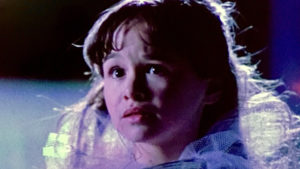
Jamie Lloyd (Danielle Harris) is seven years old and Halloween is just around the corner. She wants to be happy about it like other kids her age, but that’s impossible. She’s still reeling from the car accident that claimed the life of her mother (Laurie Strode) and father (assumed to be Jimmy, the surviving paramedic from HALLOWEEN 2) and has since been adopted by the Carruthers family. But there’s even more going on that she’s not privy to: in a move wisely avoiding being derivative of HALLOWEEN 2’s third-act twist, the audience is fully aware of who Jamie Lloyd is and her blood connection to Michael Myers. Though she has inexplicable dreams about him, referring to him as “the Nightmare Man,” she’s mercifully unaware of their family ties…unlike everyone else in Haddonfield, who know of or remember the sixteen people he killed a decade ago (an inaccurately high figure used in both marketing materials and the film itself), including the kids at school who bully her relentlessly, Tommy-Doyle-style.
Bringing all of that trauma to her performance is an uncannily good Danielle Harris, who was only nine years old at the time of filming. Even though she’d worked scantly in television before her feature debut with HALLOWEEN 4, Harris proved she had the chops to be a sympathetic and likeable lead. With an almost unreasonable amount of dramatic responsibility, Harris is tasked with carrying the conflict of the movie on her shoulders, and when she ends her first scene with hugging a shoebox containing the photos of her dead parents on the floor of her closet and sobbing from her nightmares of the boogeyman, there’s no way you don’t feel for her.
HALLOWEEN 4 also marks the return of a familiar, reassuring, and haunted face: Donald Pleasance, who dons the trench coat of Dr. Loomis for a third time, and in a way that tests the durability of the phrase “suspension of disbelief.” Despite his valiant attempt to blow up Michael and himself at the conclusion of HALLOWEEN 2, which HALLOWEEN 4’s opening exposition dump reduces to Loomis “setting him on fire,” both have survived, though badly scarred. (A proposed but unfilmed opening for HALLOWEEN 4 picked up at the end of HALLOWEEN 2, which had Loomis begging firefighters dousing the flames on Michael Myers to “let him burn”—which HALLOWEEN KILLS was happy to borrow.) When word hits that the ambulance transporting Michael to Smith’s Grove Sanitarium is found crashed and overturned below a bridge with all personnel dead and Michael missing, Dr. Loomis unpacks his steel-plated pistol and heads to Haddonfield, hoping to warn everyone in time that the boogeyman has returned.
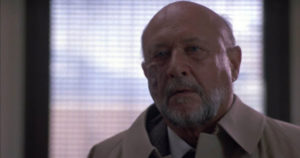
Though Loomis essentially plays the same version of the character as before, this time he’s doing so with ten more years on his face and in his voice, and with ten more years of regret in his heart. In HALLOWEEN and HALLOWEEN 2, Loomis was curt, bossy, and domineering, but always with Haddonfield’s safety at heart. That bossiness remains, but this time it comes from a place of pure desperation. Though he’s not offered any standout monologue moments like his famous “devil’s eyes” scene from the original, he’s still given plenty of opportunities to chew the scenery, either by letting loose in explosive confrontational moments with cynical characters or by ably selling some pretty heavy-handed dialogue. (No one else could have pulled off, “They survived this ordeal; they’ll survive its memory.”) Along with the original, HALLOWEEN 4 presents the most archetypal iteration of Sam Loomis—the one that strays closest to fans’ perceptions of who the character is, what he looks like, and how haunted and broken he’s become over his self-professed failures.
There comes a time when a topic can become exhaustively over-explored, which is why I’ve spent years writing about the HALLOWEEN series without ever specifically writing about the original, and which is why I’m also having trouble adequately celebrating the talents and legacy of Donald Pleasance. There’s absolutely nothing new to be said about him. Somehow, even the word “legend” feels lacking when addressing his power as an actor, his immortal staying power as Dr. Loomis (it’s the defining role of his career, yet he wasn’t Carpenter’s first choice), and whose sad eyes and obsessive madness will be sorely missed in every HALLOWEEN sequel to come. In HALLOWEEN 4, he turns Loomis up to eleven. The guilt and determination that’s driven him thus far has metastasized into maddening fixation; he’s gone from a psychiatrist disillusioned by his failure to counsel a child to a bounty hunter on the prowl in hopes of destroying the murderous man that child has become. His transformation into Ahab is complete and only death will stop him from hunting his white whale.
In response to savvier audiences, HALLOWEEN 4 smartly tweaks the concept of the “final girl,” made iconic by Jamie Lee Curtis, in an effort to keep the formula fresh while also remaining loyal to it. The screenplay by Alan McElroy deconstructs and redistributes the “final girl” title among our two female leads, maintaining all the expected characteristics but presenting them in a different dynamic. It’s the character of Rachel (Ellie Cornell) that falls in line with the classic heroic sense of the final girl, proving herself to be Ripley-tough—and not just against The Shape, but in everyday life when fending off her aggressive boyfriend, Brady (Sasha Jenson), or marking her territory against drugstore sexpot Kelly (Kathleen Kinmont), her competition for his affections. “Wise up to what men want,” Kelly tells her, all but confirming Rachel’s virginity—again in keeping with the final girl’s characteristic purity. Like Laurie Strode, Rachel is smart, capable, and aware of what’s going on around her, even when dealing with her own teenaged angst. Little Jamie, however, because of her age and the emotional baggage she carries, takes on the umbrage of the final girl’s victimization as the killer’s ultimate target, forced to endure most of The Shape’s wrath and unending rage. In response, Rachel has to be the strong one; she becomes the Kyle Reese to Jamie’s Sarah Connor, and with her parents out of town and Haddonfield’s remaining finest chasing down drunken, friendly-firing vigilantes, she’s the only one who can save her stepsister.
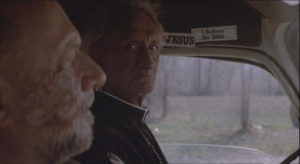
Really, all of the screenplay is well constructed, with evident thought behind every creative decision. The movie’s best scripted scene is the one shared between Loomis and the eccentric Reverend Jackson P. Sayer (adorable character actor Carmen Filpi), who is kind enough to give Loomis a ride after his explosive confrontation with The Shape leaves him stranded on the road. Once Sayer’s antiquated truck appears to materialize within a cloud of dust, as if divine intervention—as if he’s an angel putting Loomis back on the path to his fate—the two share a drink…and a conversation about the apocalypse. “It always has a face and a name,” Sayer claims, and Loomis can only agree. Both men acknowledge they are seeking the same thing, but both are seeking it in different places. Had this scene been excised from the final draft or first edit, no one beyond the writer would’ve noticed, but it’s small touches like this that make HALLOWEEN 4 special. The mere mention of this end-times theme elevates this entry while enhancing Carpenter’s initial concept of “evil” as a force as opposed to a philosophy, and in what form we’re all expecting it to manifest…because if we’re all looking for something different, we’re doomed to let it pass right by.
Taking over the command for Sheriff Brackett (Charles Cyphers in the previous films) is Ben Meeker, played exceedingly well by character actor Beau Starr (GOODFELLAS). His portrayal of Meeker as a no-nonsense lawman turns a potentially forgettable supporting role into strong and memorable work, and his first scene with Dr. Loomis establishes the makeup of his character. Upon Loomis entering the Haddonfield Police Department and telling them of Michael’s return, Meeker resists believing it from sheer audacity, but once Loomis convinces him, he doesn’t waste time. “What the hell can we do to prevent a repeat of ten years ago?” he growls, proving to be far more proactive and powerful than Sheriff Brackett ever was…but that’s because Brackett had been the overseer of a small, quiet, pre-tragedy town where nothing ever happened except for kids playing pranks, parking, and getting high. It’s Meeker who lords over post-tragedy Haddonfield, cursed with the knowledge that bad things can happen even in the sleepiest of towns and remaining on mental reserve just in case the Myers shit ever again hits the Haddonfield fan. Following Loomis’s revelation, he immediately scoops up The Shape’s likeliest targets and barricades them inside his fortified home outfitted with steel doors, a battery-powered CB radio, and of course, a robust arsenal. Ironically, in spite of how prepared he may have been, like his predecessor, Meeker suffers the loss of his daughter to The Shape; as has been a constant theme in the series, it would seem no amount of preparedness is enough when fate comes calling. The characters in HALLOWEEN and HALLOWEEN 2 made foolish choices and engaged in reckless behavior because they didn’t share the omniscient view of the audience and didn’t know of the danger creeping up on them in the dark. In HALLOWEEN 4, every character is given clear indication of the danger they’re in and every character makes the smartest possible decision in the moment, and yet most characters don’t survive the night. “Fate never changes,” indeed.
George Wilbur provides a perfectly satisfying performance as The Shape (with some assistance from FRIDAY THE 13th series alumnus Tom Morga), which is sometimes undone by the less interesting costume catalog mask and the hilariously thick shoulder pads that make him look like he’s got on a few mom sweaters beneath his jumpsuit. Thankfully, Wilbur is able to counteract much of his character’s clumsy presentation with his subtle mannerisms and rock-solid stature. His stillness aids in the film’s ostensibly purposeful choice to present The Shape as slowly reforming after his ten-year coma: his first appearance has him wrapped in mummy-like bandages and strapped, unmoving, to a hospital gurney, his flaccid hand hanging loosely at his side…but then on his feet with his hospital gown hanging off him like shedding skin…and then free of his hospital garb and inside a freshly obtained mechanic’s jumpsuit…and then, finally, within a brand-new mask. The newfound knowledge of his niece’s existence has given him “purpose” again, and that purpose shows him regenerating until he’s back to being the masked maniac that’s lived only within the nightmares of Haddonfield for the last decade.
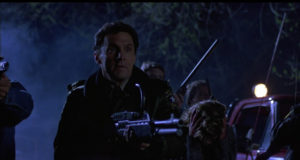
Though his screen time is limited, even Michael Pataki (ROCKY 4) as Hoffman, medical administrator at Ridgemont Federal Sanitarium, offers a new dynamic as the “other” doctor—not the one chasing down evil in the night, but the one faced with the uncomfortable logistics and potential liability of keeping a comatose and evidently indestructible murderer in his hospital. Hoffman doesn’t want Michael destroyed, vanquished, or exorcised of the “evil” inside him—he just wants him gone and out of his medical jurisdiction. “Michael Myers is now in your hands,” he says to the Smith’s Grove personnel who come to transport him away from Ridgemont—and he says it for a reason: it’s his disclaimer, his end-of-watch sign-off, his mandate that whatever happens with Michael in the future won’t fall on his head. And yet his last scene sees him watching from the shore as Dr. Loomis, undaunted, walks into a shallow creek to examine the bloodied and mangled transport ambulance that’s been driven off the road. It’s then Hoffman understands Loomis has been right all along, that realization reflecting in his sorrowful eyes.
Director Dwight Little (of MARKED FOR DEATH fame, also starring Danielle Harris) deserved a more prolific career directing features, but he eventually made the successful jump to television, having helmed episodes of THE X-FILES, PRISON BREAK, and 24. Similar to Hollywood’s modern practices, an independent film called BLOODSTONE caught the attention of Moustapha Akkad, who offered the unknown director the gig. Little proved he was the right man to follow in Carpenter’s footsteps, insisting on rich storytelling, fleshed out characters, mood, and terror. Little knows when to dial it back and rest on suspense, and he knows when to kick things into gear and get the pulse racing. Just look to the opening credit sequence—it doesn’t feature the usual single glowing jack-o-lantern hugged by blackness or a montage of newspaper clippings to get us all caught up. Instead, Little presents static, abstract shots of small-town Haddonfield—Americana, really—on the cusp of October 31st. Familiar icons like pumpkins, skeletons, and scarecrows wielding rusty hatchets are on display in midwestern farmland settings and set to ominous, non-melodic music by returning composer Alan Howarth. That opening sequence exists for no other reason than to show you that behind Haddonfield’s Halloween is an underbelly of fear and blood—that for other places in the world, Halloween is just another holiday, but in this small Illinois town, it’s a reminder of wounds long scarred over yet nowhere near healed.
Though Michael’s carnage fills the streets and quite a few bodies drop, HALLOWEEN 4 is only occasionally violent, obscuring or suggesting much of its bloodletting and mostly falling back on a restrained approach. When compared to the entries in the FRIDAY THE 13th, PHANTASM, and NIGHTMARE ON ELM STREET franchises released that same year, all of which perpetrated an eye-popping level of violence against their audiences, HALLOWEEN 4 was downright tame—and that’s because Little looked to Carpenter’s original for inspiration. Dark and shadows, camera tricks suggesting violence without showing it, fleeting glimpses of The Shape, an emphasis on developed and likeable characters—these are things that made the first film great, and they are also the things that make HALLOWEEN 4 more than just another sequel. But in a move echoing HALLOWEEN 2‘s troubled production, several days of additional shooting occurred to beef up the movie’s violence in favor of audience expectations, as early cuts had been stingy with the gore. This minor meddling isn’t a detriment, however; sudden violence in a movie otherwise trying to avoid it still contains the power to shock, whether or not it runs congruently with the director’s intention.
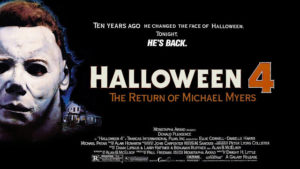
Little isn’t content to just crib from Carpenter’s playbook, though, infusing new concepts into the series and new ways to execute them. The movie’s last act, in which some truck-driving good-ol-boys transport Rachel and Jamie out of Haddonfield, is the highlight of HALLOWEEN 4, filled with propulsive action and bonafide fear, as Michael dispatches one character after the other, tearing faces, stabbing spines, and tossing them off a speeding truck. The entire sequence is sublime, embracing one of the core philosophies of the sequel: go bigger. Like the first HALLOWEEN, the action of HALLOWEEN 4 builds and builds before “ending” inside a dark suburban home, but unlike the first film, The Shape doesn’t disappear into the night because he’s not yet done with our characters. The carnage continues, spilling out of that dark suburban home and onto its own high-peaked roof before ending up on the nearest highway out of town, not only opening up the “world” of Haddonfield but eerily reminding the audience that Michael Myers can go anywhere—that he’s not constrained by a town boundary line—that all he needs is a ride. And as for that shock ending, holy fuck. That last-act moment of Jamie holding those bloody scissors and Loomis seeing his vilest nightmare starting over from the beginning and shouting himself hoarse before beginning to sob—all playing out over the HALLOWEEN theme—has never once failed to give me chills.
Speaking of, HALLOWEEN 4 sees longtime series composer Alan Howarth going solo without Carpenter for the first time, and though he’s eager to jump right into the HALLOWEEN theme, he’s sly with his approach. While the film utilizes the infamous theme several times, it never sounds the same from one sequence to the next: when The Shape is being loaded onto the Smith’s Grove ambulance, it’s propulsive and ominous; when the convoy of beer bellies are patrolling the town with their rifles and shotguns, it’s focused and militaristic; and when The Shape is on the roof of the truck during the highway finale, the theme truly comes to life—it’s quick-paced, frantic, and relentless, matching the most action-oriented sequence seen in the series up to that point. Outside of the main theme, Howarth doesn’t rest on his laurels and barely revisits some of the previous movies’ themes, intent on injecting his own original music into the franchise. Like the very movie he’s scoring, Howarth’s music is the peak of his solo work across all the sequels.
HALLOWEEN 4: THE RETURN OF MICHAEL MYERS was a new beginning for the re-born series, but also the beginning of the end, as the next two lackluster sequels would get mired in new directions so strange and mythology so confounding that audience interest couldn’t sustain, leading the series to be retconned twice—first by 1998’s HALLOWEEN: H20, which rendered parts 4-6 irrelevant, and again by 2018’s sequel, which rendered everything irrelevant except Carpenter’s original. Until this era of reboots and retcons, HALLOWEEN 4 had been the only worthwhile entry that preserved the core story begun in 1978 and had proven to be the last entry that focused more on thrills, suspense, and well-developed characters as opposed to one-dimensional bloodbags destined for garish and graphic kill scenes. Poor HALLOWEEN 4 had done the impossible: resurrected the boogeyman, created new characters to carry the mantle, and revived the series after HALLOWEEN 2 had concluded it and HALLOWEEN 3 had reinvented it. Time has proven the series’ intermittent fresh-start approach to be the right call each time, as they consistently returned reasonable respectability to the HALLOWEEN name, even if they left behind a wacky trajectory of three different continuities for fans to navigate. Proving that is the fresh release of the polarizing and disappointing HALLOWEEN KILLS, which sees interest in the series at an all-time high while once again boasting the return of Jamie Lee Curtis in her sixth appearance as Laurie Strode, the quintessential final girl. (Her seventh and “final” go-round will be in next year’s HALLOWEEN ENDS.) Though HALLOWEEN: H20 was the first sequel to reboot the Michael Myers story and resurrect its towering reputation after the dismal HALLOWEEN 6 (which had done so much damage to the series that the initial version of HALLOWEEN 7 sans Curtis was destined for a direct-to-video debut), it was also a little sad: seeing Laurie Strode battle the boogeyman once again was the stuff of fan dreams, but her return to the series had erased her daughter completely out of existence—and while HALLOWEEN: H20 was a worthy sequel, it was no HALLOWEEN 4.
Tags: Alan B. McElroy, Alan Howarth, Beau Starr, Carmen Filpi, Danielle Harris, debra hill, Donald Pleasance, Dwight H. Little, Dwight Little, Ellie Cornell, George P. Wilbur, halloween, Halloween 4, john carpenter, Kathleen Kinmont, Laurie Strode, Michael Myers, Michael Pataki, Moustapha Akkad, Sasha Jenson, Screamquels, Sequels, The Return of Michael Myers, The Shape, Tom Morga, Trancas Films

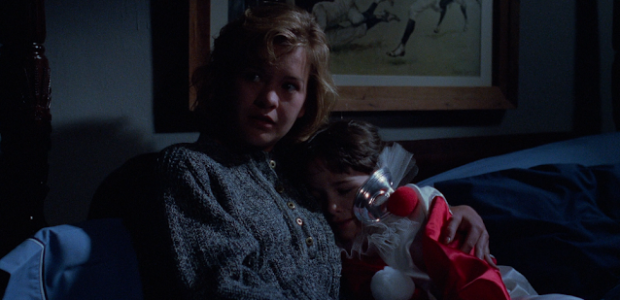

No Comments